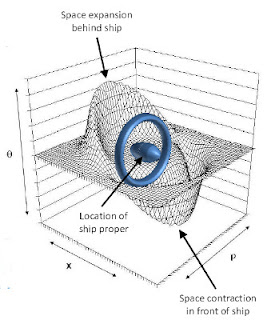"… [it] is shown how, within the framework of general relativity and without the introduction of wormholes, it is possible to modify a spacetime in a way that allows a spaceship to travel with an arbitrarily large speed. By a purely local expansion of spacetime behind the spaceship and an opposite contraction in front of it, motion faster than the speed of light as seen by observers outside the disturbed region is possible. The resulting distortion is reminiscent of the ‘warp drive’ of science fiction." (Alcubierre paper abstract)
By placing a spheroid object between two regions of space-time — one expanding, the other contracting — Alcubierre theorized you could create a “warp bubble” that moves space-time around the object, effectively re-positioning it. In essence, you’d have the end result of faster-than-light travel without the object itself having to move (with respect to its local frame of reference) at light-speed or faster.
The only catch: Alcubierre says that, “just as happens with wormholes,” you’d need “exotic matter” (matter with “strange properties”) to distort space-time. And the amount of energy necessary to power that would be on par with — wait for it — the mass-energy of the planet Jupiter.
So we’re back to “fuhgeddaboudit,” right?
Maybe not. According to NASA physicist Harold White, the energy problem may actually be surmountable by simply tweaking the warp drive’s geometry.
White, who just shared his latest ideas at the 100 Year Starship 2012 Public Symposium, says that if you adjust the shape of the ring surrounding the object, from something that looks like a flat halo into something thicker and curvier, you could power Alcubierre’s warp drive with a mass roughly the size of NASA’s Voyager 1 probe.
In other words: reduction in energy requirements from a planet with a mass equivalent to over 300 Earths, down to an object that weighs just under 1,600 pounds.
Time Tech: NASA Actually Working on Faster-than-Light Warp Drive

Comments